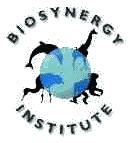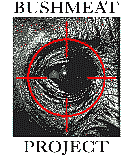CONSERVATION AND SOCIAL CHANGE
A SERIES OF CHAPTERS PUBLISHED IN ANTHOLOGIES DURING RECENT YEARS THAT FOCUS ON THE HUMAN FACTORS WHICH INFLUENCE THE CONSERVATION OF WILDLIFE, INDIGENOUS PEOPLE, AND WILDERNESS. CLICK CHAPTER TITLE FOR COMPLETE CHAPTER PDF.
WE MUST CHANGE PEOPLE IN ORDER TO SAVE GORILLAS: CONSERVATION VALUES EDUCATION IN RURAL CAMEROON. Anthony L. Rose, Penelope Fraser, & Rita Lysinge. (Chapter prepared for new volume on Gorilla Conservation, to be published in 2004).
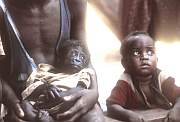 Worldwide, millions of people work in fields related to the social sciences. Psychology, anthropology, sociology, political science, history, and economics are basic disciplines which inform fields such as education, marketing, organization & community development, justice and law enforcement, communication and linguistics, politics and diplomacy, military strategy, and many others. Basic and applied social science research enhances our academic understanding and our practical ability to predict and control attitudes and behaviors, interpersonal dynamics, and social change. Sadly, the involvement of social scientists in the wildlife conservation arena is minimal, even though it is accepted by most conservationists that the job of saving wildlife “has more to do with clothed people than hairy animals”. Our intention in this chapter is to initiate a process that merges social science and conservation agendas. We shall do this by exploring the fascinating discoveries that have emerged from our efforts to study and inspire conservation values in people who live in some of the most challenging biodiversity hotspots in west and central Africa.
Worldwide, millions of people work in fields related to the social sciences. Psychology, anthropology, sociology, political science, history, and economics are basic disciplines which inform fields such as education, marketing, organization & community development, justice and law enforcement, communication and linguistics, politics and diplomacy, military strategy, and many others. Basic and applied social science research enhances our academic understanding and our practical ability to predict and control attitudes and behaviors, interpersonal dynamics, and social change. Sadly, the involvement of social scientists in the wildlife conservation arena is minimal, even though it is accepted by most conservationists that the job of saving wildlife “has more to do with clothed people than hairy animals”. Our intention in this chapter is to initiate a process that merges social science and conservation agendas. We shall do this by exploring the fascinating discoveries that have emerged from our efforts to study and inspire conservation values in people who live in some of the most challenging biodiversity hotspots in west and central Africa.
BUSHMEAT, PRIMATE KINSHIP, AND THE GLOBAL CONSERVATION MOVEMENT. Anthony L. Rose. Pp. 241-258 in Galdikas et al (Eds), All Apes Great and Small Volume 1: Chimpanzees, Bonobos, and Gorillas, Kluwer Press, New York, 2001.
It is said in theory and affirmed by research that the major revolutions in any science, and in most pursuits of knowledge, are set off primarily by players who come to an issue from outside the traditional domains of its study. In this position paper that premise is put to work. Primatologists from laboratory to field station have focused on nonhumans, trading on their understanding of apes and monkeys to postulate theories of 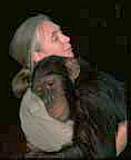 mind, tenets of social behavior, and principles of biodiversity. The opposite is done here. In this treatise I describe findings and theories in human values, behavior, and social systems on the penultimate challenge to biological disciplines: conservation. Few will contest the fact that conservation is a decidedly human affair, and that its problems and practices have more to do with clothed people than hairy animals. Here I explore the human factors that are transforming conservation from a narrow biological endeavor to a massive social movement. Inter-disciplinary thinking is fundamental to the social movement that wildlife conservation must become in the era of bushmeat and primate kinship.
mind, tenets of social behavior, and principles of biodiversity. The opposite is done here. In this treatise I describe findings and theories in human values, behavior, and social systems on the penultimate challenge to biological disciplines: conservation. Few will contest the fact that conservation is a decidedly human affair, and that its problems and practices have more to do with clothed people than hairy animals. Here I explore the human factors that are transforming conservation from a narrow biological endeavor to a massive social movement. Inter-disciplinary thinking is fundamental to the social movement that wildlife conservation must become in the era of bushmeat and primate kinship.
CONSERVATION MUST PURSUE HUMAN-NATURE BIOSYNERGY IN THE ERA OF SOCIAL CHAOS AND BUSHMEAT COMMERCE. Anthony L. Rose. Pp. 158-184 in Fuentes & Wolfe (Eds), Conservation Implications of Human and Nonhuman Primate Interconnections, Cambridge University Press, 2002.
While social chaos spreads across equatorial Africa, human predation has become the most urgent threat to African primates. The explosion of commercial bushmeat hunting is destroying primate populations faster than their habitat can be cut down. The failure of conservation in great ape range countries is due to primarily to human crises -- poverty, illness, war, commercial greed, political corruption, lawlessness. There is a revolution going on in equatorial Africa, and it is being perpetrated by international exploiters who are radically manipulating the social order and cultural values of the African people so as to serve their personal and corporate pursuit of power and money. Because of this assault on African life ways and values, social change and turmoil are the rule. In this milieu the practice of conservation must become proficient at understanding the context for change and working with its problems, causes, and solutions.


SOCIAL CHANGE AND SOCIAL VALUES IN MITIGATING BUSHMEAT COMMERCE. Anthony L. Rose. Pp. 59-74 in Bakarr, Fonseca, Mittermeier, Rylands, & Walker (Eds), Hunting & Bushmeat Utilization in African Rain Forests, Conservation International, Washington, DC, 2001.
It has long been argued that consensus to act in conservation research and development must include all stakeholders. On one political level, this has come to mean “when planning for Africa, include Africans.” This expansion is necessary, but not sufficient. We must step back to ask who is planning – which Africans, which internationals? What are their values, their biases, their levels of expertise and competence? Whom and what do they represent? And, as stakeholders, what is their stake in this? Professionals in applied science who have a stake in the endeavors and disciplines required to confront the bushmeat crisis reach far beyond those now eminent in the field. Leadership in the wildlife conservation movement has spread from naturalists and wildlife biologists to include ecologists, anthropologists, and, more recently, economists and political scientists. Still, this widened spectrum does not cover many important disciplines and fields of endeavor. I have argued that a broad inclusiveness is imperative to underpin conservation planning. Now, in the face of burgeoning commerce in wildlife meat, that call for broadbased professional and personal collaboration is doubly important. In this chapter, I attempt to sketch a theoretical blueprint for understanding and effecting lasting social change in the bushmeat arena.
ORANGUTAN, SCIENCE, AND COLLECTIVE REALITY. Anthony L. Rose. Pp. 29 -- 40 in Nadler, Galdikas, Rosen, & Sheeran (Eds), Orangutan -- The Neglected Ape. Plenum Press, New York, 1996.
The future of orangutan conservation and research is tied to public perceptions and to the government and corporate powers that react to and shape the collective realities of their constituents. It is time for primatologists to organize to influence those collective realities. Crucial to this effort is the reconciliation of contrasting metaphors based on the objective, interpretive, and interactive perceptions of orangutan which are reported by experimental scientists, field naturalists, and clinical practitioners. This treatise begins such a reconciliation by comparing reports of profound interspecies events (PIEs) -- social phenomena identified and studied by the author, that relate directly to primatologists' different value laden perceptions of nature. The relative effectiveness of scientific, naturalistic and humanistic scenarios in evoking human concern for wildlife must be considered when deciding which stories to tell and how to tell them. Pitfalls in reporting orangutan behavior in two perceptually "hot" areas, sexual behavior and male dominance, are discussed. A collaborative strategy is presented for producing and promoting collective realities that will promulgate the safety and well-being of orangutans in captivity, in sanctuary, and in their native habitats.
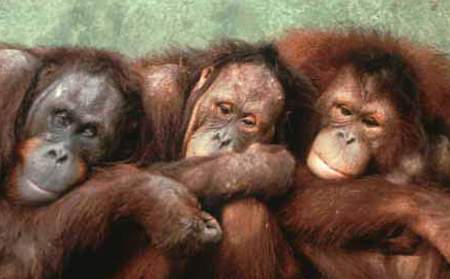
All Photos-- © 2003 Karl Ammann ~~ http://karlammann.com

